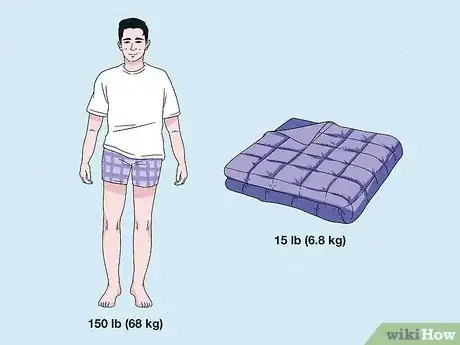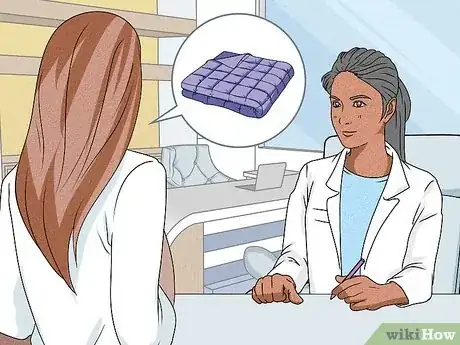This article was co-authored by Nancy Lin, PhD and by wikiHow staff writer, Dan Hickey. Dr. Nancy Lin is a Licensed Clinical Psychologist and the Owner of Go to Sleep San Diego, a private practice providing therapy for people suffering from insomnia, trauma, depression, and related problems. She is also trained in issues related to cultural diversity in mental health. Dr. Lin holds a Bachelors degree in Psychology from The University of California, Berkeley and a Masters degree in Medical Anthropology from the University of London, SOAS. She earned her Ph.D. in Clinical Psychology from The University of Massachusetts Boston and completed an APA-accredited internship and postdoctoral training at the VA San Diego Healthcare System (VASDHS).
There are 9 references cited in this article, which can be found at the bottom of the page.
This article has been viewed 3,739 times.
Weighted blankets can improve your sleep and soothe anxiety, but how do you pick the right one when there are so many options? Although the biggest factors are your personal preference and comfort, there are helpful standard guidelines to help you make a safe, comfortable, and cost-effective choice. If you’re ready to snuggle up under the perfect weighted blanket tonight, keep scrolling!
Things You Should Know
- Choose a blanket that’s about 10% of your body weight for individual use, or 7.5% of your combined bodyweight if you’re sharing with a partner.
- Opt for a size that covers you from chin to foot and won’t hang very far off the edge of your bed.
- Consult a doctor before buying a weighted blanket for children, the elderly, or people with strength and mobility issues.
Steps
Expert Q&A
-
QuestionDo weighted blankets help you sleep?
 Nancy Lin, PhDDr. Nancy Lin is a Licensed Clinical Psychologist and the Owner of Go to Sleep San Diego, a private practice providing therapy for people suffering from insomnia, trauma, depression, and related problems. She is also trained in issues related to cultural diversity in mental health. Dr. Lin holds a Bachelors degree in Psychology from The University of California, Berkeley and a Masters degree in Medical Anthropology from the University of London, SOAS. She earned her Ph.D. in Clinical Psychology from The University of Massachusetts Boston and completed an APA-accredited internship and postdoctoral training at the VA San Diego Healthcare System (VASDHS).
Nancy Lin, PhDDr. Nancy Lin is a Licensed Clinical Psychologist and the Owner of Go to Sleep San Diego, a private practice providing therapy for people suffering from insomnia, trauma, depression, and related problems. She is also trained in issues related to cultural diversity in mental health. Dr. Lin holds a Bachelors degree in Psychology from The University of California, Berkeley and a Masters degree in Medical Anthropology from the University of London, SOAS. She earned her Ph.D. in Clinical Psychology from The University of Massachusetts Boston and completed an APA-accredited internship and postdoctoral training at the VA San Diego Healthcare System (VASDHS).
Licensed Clinical Psychologist Weighted blankets may help you fall asleep if you're feeling anxious or stressed. In that case, a weighted blanket can feel like a hug or a comforting cocoon. Since it helps relax you, the blanket can help you fall asleep. However, weighted blankets might not help you if you have trouble sleeping for a different reason.
Weighted blankets may help you fall asleep if you're feeling anxious or stressed. In that case, a weighted blanket can feel like a hug or a comforting cocoon. Since it helps relax you, the blanket can help you fall asleep. However, weighted blankets might not help you if you have trouble sleeping for a different reason. -
QuestionDo weighted blankets make you hot?
 Nancy Lin, PhDDr. Nancy Lin is a Licensed Clinical Psychologist and the Owner of Go to Sleep San Diego, a private practice providing therapy for people suffering from insomnia, trauma, depression, and related problems. She is also trained in issues related to cultural diversity in mental health. Dr. Lin holds a Bachelors degree in Psychology from The University of California, Berkeley and a Masters degree in Medical Anthropology from the University of London, SOAS. She earned her Ph.D. in Clinical Psychology from The University of Massachusetts Boston and completed an APA-accredited internship and postdoctoral training at the VA San Diego Healthcare System (VASDHS).
Nancy Lin, PhDDr. Nancy Lin is a Licensed Clinical Psychologist and the Owner of Go to Sleep San Diego, a private practice providing therapy for people suffering from insomnia, trauma, depression, and related problems. She is also trained in issues related to cultural diversity in mental health. Dr. Lin holds a Bachelors degree in Psychology from The University of California, Berkeley and a Masters degree in Medical Anthropology from the University of London, SOAS. She earned her Ph.D. in Clinical Psychology from The University of Massachusetts Boston and completed an APA-accredited internship and postdoctoral training at the VA San Diego Healthcare System (VASDHS).
Licensed Clinical Psychologist Weighted blankets may make you feel hot as the night goes on. You typically want to feel bundled up as you fall asleep. However, you'll likely want to cool off after you've been asleep for a while. Since weighted blankets are heavy, you may not be able to shift from under the blanket in your sleep, which can make you hot.
Weighted blankets may make you feel hot as the night goes on. You typically want to feel bundled up as you fall asleep. However, you'll likely want to cool off after you've been asleep for a while. Since weighted blankets are heavy, you may not be able to shift from under the blanket in your sleep, which can make you hot.
Warnings
- Do not let children under 3 years old or 50 pounds (23 kg) use a weighted blanket without consulting a pediatrician.[15]⧼thumbs_response⧽
- Talk to a doctor about using a weighted blanket if you have low blood pressure, a respiratory disorder, type 2 diabetes, or obstructive sleep apnea.[16]⧼thumbs_response⧽
References
- ↑ https://www.psychologytoday.com/us/blog/lets-talk-about-mental-health/202012/should-you-get-weighted-blanket
- ↑ https://www.inc.com/minda-zetlin/weighted-blankets-better-sleep-deep-pressure-stimulation-reduced-anxiety.html
- ↑ https://whatasleep.com.au/blog/how-to-choose-a-weighted-blanket/
- ↑ https://www.sleepfoundation.org/bedding-information/weighted-blanket-weight-chart
- ↑ https://whatasleep.com.au/blog/how-to-choose-a-weighted-blanket/
- ↑ https://whatasleep.com.au/blog/how-to-choose-a-weighted-blanket/
- ↑ https://whatasleep.com.au/blog/how-to-choose-a-weighted-blanket/
- ↑ https://health.clevelandclinic.org/can-weighted-blankets-banish-nighttime-anxiety/
- ↑ https://www.todaysparent.com/family/special-needs/everything-you-need-to-know-about-weighted-blankets/
- ↑ https://www.sleepfoundation.org/bedding-information/weighted-blanket-benefits
- ↑ https://www.washingtonpost.com/lifestyle/home/weighted-blankets-might-ease-insomnia-and-anxiety-heres-what-to-know-before-buying-one/2019/01/18/71b1aefa-1a6f-11e9-8813-cb9dec761e73_story.html
- ↑ https://www.sleepfoundation.org/bedding-information/how-to-wash-a-weighted-blanket
- ↑ https://www.sleepfoundation.org/bedding-information/weighted-blanket-benefits
- ↑ https://www.inc.com/minda-zetlin/weighted-blankets-better-sleep-deep-pressure-stimulation-reduced-anxiety.html
- ↑ https://www.sleepfoundation.org/bedding-information/weighted-blanket-weight-chart
- ↑ https://www.sleepfoundation.org/bedding-information/weighted-blanket-weight-chart
































































